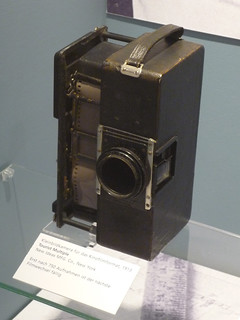Difference between revisions of "Tourist Multiple"
m |
Danipuntocom (talk | contribs) (added image) |
||
| Line 1: | Line 1: | ||
| + | {{Flickr_image | ||
| + | |image_source=https://www.flickr.com/photos/danipuntocom/15318914875/in/pool-camerawiki | ||
| + | |image=http://farm4.staticflickr.com/3921/15318914875_849987a036_n.jpg | ||
| + | |image_align=right | ||
| + | |image_text=Tourist Multiple (1913)<br><small>Deutsches Technikmuseum Berlin | ||
| + | |image_by=Danipuntocom | ||
| + | |image_rights=nc | ||
| + | }} | ||
| + | |||
The history of the 35mm [[half-frame]] cameras began in 1913 with a "full-frame" camera. That's because the [[35mm film]] camera '''Tourist Multiple''' delivered the ''full'' 18×24mm [[35mm]] cine-film movie frame format. It was made by Herbert & Huesgen, New York. 12 years later this "full-frame" cine format became the [[half-frame]] still camera format because the [[Leica A|Leica Ia]] became a huge success, defining 24×36mm as standard for [[miniature]] still cameras. | The history of the 35mm [[half-frame]] cameras began in 1913 with a "full-frame" camera. That's because the [[35mm film]] camera '''Tourist Multiple''' delivered the ''full'' 18×24mm [[35mm]] cine-film movie frame format. It was made by Herbert & Huesgen, New York. 12 years later this "full-frame" cine format became the [[half-frame]] still camera format because the [[Leica A|Leica Ia]] became a huge success, defining 24×36mm as standard for [[miniature]] still cameras. | ||
Revision as of 15:52, 22 September 2014

|
| Tourist Multiple (1913) Deutsches Technikmuseum Berlin image by Danipuntocom (Image rights) |
The history of the 35mm half-frame cameras began in 1913 with a "full-frame" camera. That's because the 35mm film camera Tourist Multiple delivered the full 18×24mm 35mm cine-film movie frame format. It was made by Herbert & Huesgen, New York. 12 years later this "full-frame" cine format became the half-frame still camera format because the Leica Ia became a huge success, defining 24×36mm as standard for miniature still cameras.